Cross-training with a mini keyboard helps you learn faster by providing different ways of seeing and practicing the same patterns. And that’s what music is: inconnecting repeating patterns. The more patterns you can learn, the more music you can play.
Why It Works
I wasn’t the best piano student ever, but when I fell in love with baritone ukulele, boy was I glad that I knew my way around a keyboard. Why? Because the keyboard is VISUAL. It’s all right there in black and white.
On piano, you can quickly and easily create a mental map of all 88 notes. Each note appears once and only once. Black keys are the sharps and flats, white keys are the natural notes (not sharp, not flat). It’s easy to see where one octave ends and the next begins.
- An octave is the distance of a major scale: doe-ray-mee-fah-so-lah-tee-doe.
- An octave is the distance from C to shining C (or B to B, or D to D, and so on).
- An octave is 12 frets on a stringed instrument.
- An octave is 12 keys on a keyboard.
Cross-training with keyboard helps you to create the mental map of notes and octaves, sharps and flats, in black and white, which you can translate to the fretboard on your bari.
Once the mental map is achieved, it will always be there for you. Then you can give your full attention to other goals like technique and repertoire.
When working through these exercises, you may find it helpful to refer to the fret maps in this article: The Baritone Uke Fretboard Step-by-Step.
Also, check out the Free Stuff page where you can find a couple of free printable worksheets that will come in handy: Notes of the Baritone Uke, and Blank Fretboard Worksheet for Baritone Ukulele.
Learning just a few of the basic repeating patterns in music can take you a long way.
Get a budget mini keyboard
Choose a mini keyboard that:
- has a built in speaker, and
- has three octaves, and
- has a C note as the lowest note (far left side, see diagram).
This type of mini keyboard has all the notes that you can play on your baritone ukulele.
The Yamaha PSS-30 “Remie” keyboard pictured below is the one I use. The piano voice is decent and it has a transpose function which I often find useful. I’ve also used a Casio, which is fine.
Some of the mini keyboards have an F note as the lowest note. If you have one of these, you’ll need the 3½ to 4 octave size in order to have all the notes that you can play on a baritone uke.
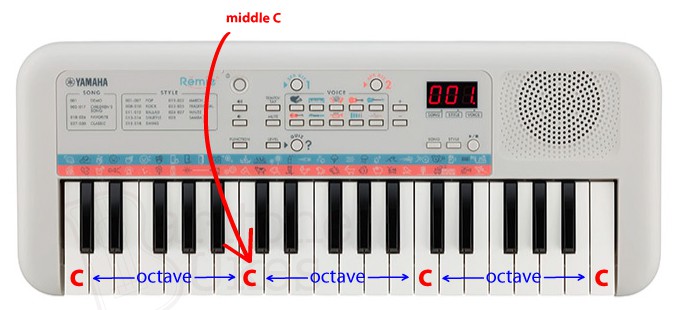
The Exercises
Exercise 1: White keys
Exercise 2: Open strings
Exercise 3: Black keys
Exercise 4: C major chord
Exercise 5: Play the bass notes of a song
Exercise 6: Quiz yourself
Exercise #1: White keys.
Within any octave is 7 white keys and 5 black keys. In Exercise 1, we’re learning the 7 white keys: A-B-C-D-E-F-G.
We’re going to start with a C note though, because C is the easiest note to find and remember on the keyboard. So we’re going to find the 7 white-key notes in this order: C-D-E-F-G-A-B.

Now play 8 white keys in order, starting with any C note, like this: C-D-E-F-G-A-B-C. Sound familiar? That’s the sound of doe-ray-mee-fah-so-lah-tee-doe, a major scale.
When you start on a C note and play 7 white keys in a row, you’ve played a C major scale. The 8th white key is another C note and begins the next octave.
Why bother?
Because one of the biggest mysteries for beginning string players is which notes have flats or sharps and which don’t. Which notes have a fret between them, and which notes are adjacent? You can make this knowledge second nature, so you don’t even have to think about it. The easiest way to do that is to “see” the mini keyboard in your mind, with the groupings of black and white keys.
On a keyboard, you can visually see that there is no black key between E and F, and there is no black key between B and C.
On your baritone ukulele, or any stringed instrument, the same concept applies. The notes B and C are on adjacent frets without a fret in between. The notes E and F are on adjacent frets without a fret in between. All the other natural notes have a fret in between, a sharp/flat.
If you only learn this one thing about keyboard, it will help you tremendously on baritione uke.
Exercise #2: Open strings.
For Excercise 2, you’re going to find the notes of your open strings on the keyboard. Here’s what it looks like:
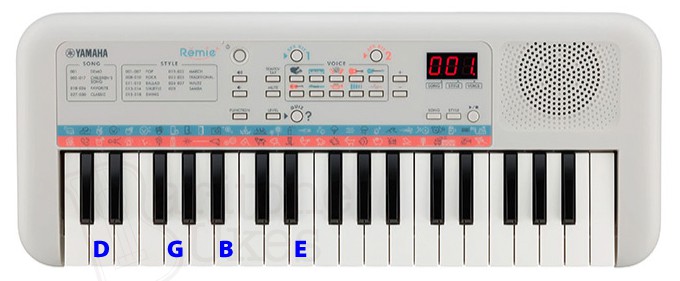
Look at the keyboard photo above and count the keys between each note of the open strings:
- Between the D string and the G string: four keys (four frets, four notes)
- Between the G string and the B string: three keys (three frets, three notes)
- Between the B string and the E string: four keys (four frets, four notes)
This simple fact is easy to see in black and white but can take time to sink in and become second nature when playing ukulele or guitar. (The interval distances on ukuleles are the same as the intervals on the four higher-pitch strings of a guitar.)
These intervals have names:
- The interval from D to G is called a perfect fourth
- The interval from G to B is called a major third
- The interval from B to E is called a perfect fourth
Seeing these intervals in black and white on a keyboard makes it much easier to understand and remember the relationships between strings.
Factoid: Compare to violin, mandolin, bass. They’re tuned symmetrically, which means any two adjacent strings have the same number of notes between them. Violins and mandolins are tuned in perfect fifths, meaning six notes and/or six frets between adjacent open strings. Bass guitar or double bass (stand-up bass) is tuned in perfect fourths, which means that any two adjacent open strings have four notes and/or four frets between them.
Exercise #3: Black keys.
Just think of a flat tire. It’s going to be lower than normal, right? That’s all there is to it. Flat notes are one fret, or one note, lower than the natural notes. Sharp notes are one fret, or one note, higher than natural notes.

Exercise #4: C Major Chord
Here’s the basic C major chord shown on the mini keyboard:
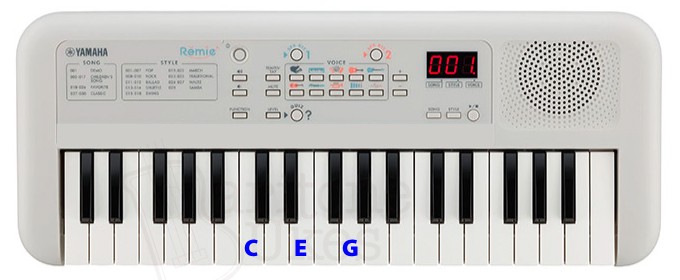
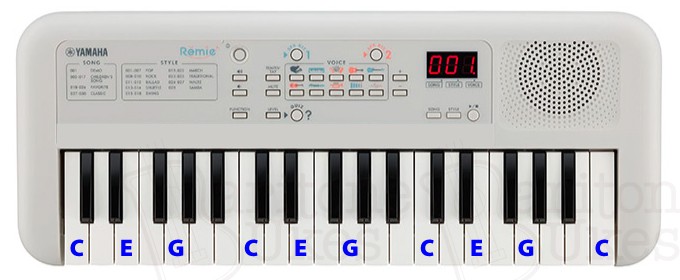
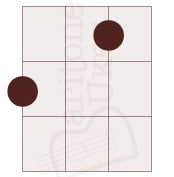
Don’t worry if this seems very confusing at first. Believe me, I’ve spent a lot of time just sitting and pondering these concepts. Sometimes it takes my brain a while to get from point A to point B. Nowadays I work on more advanced patterns and sometimes I’ll sit for an hour just working out in my mind the relationship between one pattern and another. Eventually, the fog clears, the veil lifts, and eureka! I get it.
So be patient. Breath! Detach from emotions like frustration or impatience. Take your time. It will get easier.
First you need think about which notes you’re actually playing on your bari when you play the basic open position C chord (review Exercise #2 if you need to). Here they are:
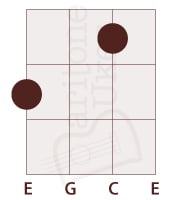
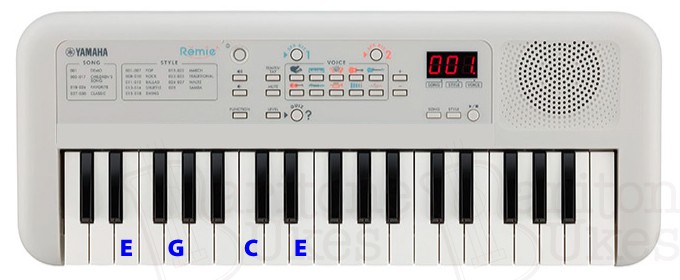
Exercise #5: Play the bass notes of a song on your keyboard
If you have a “slash chord,” like C/D for example, play the note after the slash.
Pick your easiest song and play the bass note on the keyboard. If possible, play along with a recording. You can play one bass note per chord change, or if you like you can play one bass note per beat—play the same note per beat until the next chord change.
You just learned how to play bass! Listening for this bottom note is the key to figuring out songs by ear. If you can hear the bottom note of the chord, or you can hear the note that the bass player is playing, that’s the first step in figuring out what the chord is.
Exercise #6: Quiz Yourself
2. Which notes can you find on the high end of your keyboard that don’t exist on your baritone ukulele?
3. Which notes on the keyboard appear once and only once on your bari?
4. How many places can you play a G note on your bari?
5. Where are the three octaves located on your bari?
Answers:
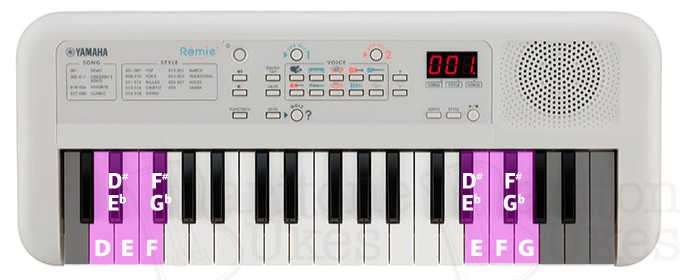
2. Depends on how many frets you have but most players aren’t going to go much higher than the 15th fret. So, using that as a limit, your highest note is G. See the gray notes on the right side above. There are five notes above the G, two black keys and three white keys.
3. See the pink notes on the diagram above. On the low end (left side), the notes are only available on the lowest string of the bari uke, the D string. On the high end (right side) of the keyboard, again it depends on how many frets you have, but let’s say you have 15 usable frets. These notes are only available on the highest string of the bari uke, the E string.
4. Six places, assuming you have 15 usable frets:
D string — 5th fret
G string — open string and 12th fret
B string — 8th fret
E string — 3rd fret and 15th fret
Check out this fret map to see a diagram of where they are. (You might also be able to reach a G on the 17th fret on the D string, but I doubt anyone would find that useful unless playing on a doube cutaway style body.)
5. Check out this fret map to see where the octaves are on your fretboard. The lowest octave is in green, the middle octave is in red, and the highest octave is in blue. Compare the colored fret map to this color-coded mini keyboard:
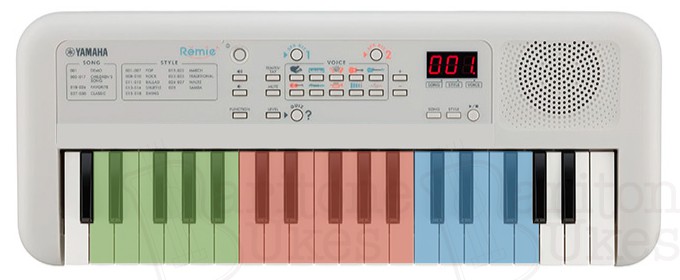
Next Steps
Ready for more? Try playing other chords on you bari uke and then finding the notes on the keyboard. Start with simple chords like G major and E minor, then move on to 7th chords.
Post in the comments below if you’d like to see a Part 2 of this article with more exercises.
Conclusion
One of my personal goals is to understand the baritone ukulele fretboard as fully as I understand the piano keyboard, to create the mental map in my mind that becomes second nature, so I instinctively know where every note and chord is located, instinctively understand the relationship between the strings, notes, intervals, and chords.
It takes time. I’ve found that coming at it from different angles makes a big difference. Everything on this site is something I created for myself, to help me in this process. Cross-training with keyboard is part of my regular musical life.
Once you get the hang of it, you’ll find that you often reach for the keyboard as a handy visual aid to help you understand your baritone ukulele fretboard faster.



0 Comments